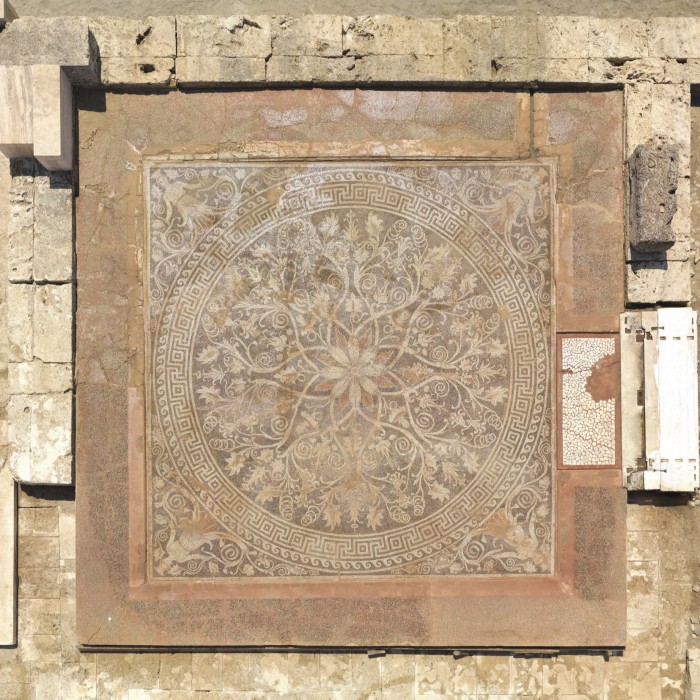plants fit for a palace

In my working and writing life I inhabit two parallel worlds, one classical, one horticultural. At times they intersect, never more so than at the superb restoration in northern Greece of the palace of King Philip II of Macedon, father of Alexander the Great. At Aigai-Vergina, about 50 minutes’ drive from Thessaloniki, the huge new museum, the site’s second, and Philip’s restored palace have been hosting hundreds of thousands of visitors since their official inauguration on January 5.
When I first wrote about this palace in my 1973 book on Alexander, I remarked that its big central space was a garden, a mark of a civilised man. I was wrong. Its courtyard, now better understood, is a solid space that opens on to big rooms for drinking and partying. Plants and flowers feature differently, as I have just seen in person, in art that gardeners will recognise.
In 1973, I was right about one thing: the location of Aigai itself, the ceremonial centre of Philip and the Macedonian kings. I took a considered risk and set the opening chapter of my book on the hill at Vergina. All other books had located it 35 miles away on a very different site, Edessa, whose steep hillside has fine views and waterfalls but not a hint of a palace or royal tombs. At Vergina a huge man-made mound was visible and the ground plan of a big palace on the hill above it, known to archaeologists since the 1870s. Nonetheless, almost every scholar believed there were good reasons for denying that it was Aigai.
My hunch was confirmed in early November 1977 when the masterly archaeologist Manolis Andronicos amazed the world by discovering four tombs beneath Vergina’s mound. None came with an identifying label, but his cautious proposal that the unlooted one was the tomb of King Philip has withstood subsequent controversy and is, frankly, correct.


In 1979, Andronicos invited me to visit his discoveries. He began by drawing back the black curtain with which he was protecting a fresco on the main tomb’s facade. It shows superb scenes of hunting: over the doorway a wreathed young figure on a prancing horse is about to throw his spear at a lion, while a separate group of young hunters around an older man on a white horse, attack it from the right. I was transfixed. The figures are not generic representations of a traditional kind. The older man is Philip and the young rider is Alexander. This contemporary portrait is the first to survive of the person on whom I had been working for years. The horse is his famed Bucephalas. Only when I regained composure did Andronicos tell me he had already reached that conclusion.
In the fresco, there is a leafless tree but no flowers. Inside another tomb, earlier than Philip’s, I then saw the wonderful fresco of young Persephone being seized by Hades, god of the Underworld. Beneath it there is a row of painted flowers, including stylised lilies: Persephone was seized while gathering flowers with her companions.
Inside Philip’s tomb, two stunning wreaths were found in gold caskets, one of gold oak leaves and acorns for himself, and an exquisite one of gold myrtle leaves and flowers for one of his wives. Myrtle was a fashionable choice. In 2017 another gold wreath of myrtle was returned to Greece by the Getty Museum in Los Angeles, as it had originated from an illegal excavation in Macedon. It is on display now in the archaeological museum in Thessaloniki. In honour of such wreaths I was already growing myrtle. At home it died in the 2022–23 winter, but in my Oxford college it survives: a pink myrtle from Paraguay (not the white one that Macedon’s jewellers portrayed).

In the palace’s grounds two huge oak trees still bear acorns, though neither existed in antiquity. Here, too, the important flowers are artistic, winding in a black and white pebbled mosaic that Macedonian guests, all men, would admire while drinking on couches around its edges. Lilies and the leaves of acanthus are mixed with curving stems and flowers, like the patterns of modern carpets. In each corner, flowers coil from the body of a lady, like a flowery spirit.
From the coins excavated in one of its rooms, this huge palace seemed to be dated to c. 270BC, about 65 years after Philip’s death. In 1988, however, a theatre was discovered on the hillside directly below it, dating to Philip’s reign — the very theatre in which he was murdered. Was the palace older than scholars thought?
After Andronicos’ death in 1992, one of his archaeological assistants, Angeliki Kottaridi, became director of the site. Brilliantly she has continued to increase the finds of royal tombs and transform their presentation to the public. It is she who designed and raised funding for the site’s two magnificent museums. In 2007, Kottaridi turned her eye and unstoppable energy to the palace, supported by funding from the EU. She and her team have achieved the near-impossible, re-erecting some of the pillars and transforming our knowledge of the building’s extent.

In July 2007 she summoned me to visit her initial work. Its scale had seemed to date it to the grand years after Alexander’s conquest of Asia, and she explained to me that the coins originally used as evidence belonged to a later refurbishment of the room in which they were found. As the moon came up, we sat on the palace’s huge retaining wall, newly unearthed by her team. I congratulated her on work so far and urged her to conduct a deeper survey to find traces of Philip’s palace underneath. I blush, now, at my impertinence: “We have done such a survey,” she replied, “and there is no trace of a palace underneath. This is King Philip’s palace: you are sitting on its wall”.
I was stunned into silence. There were still scholars who argued that Philip’s Macedon was a simple tribal society and that grand monarchy began only when Alexander conquered Egypt and encountered its scale. In fact, he grew up in a building as big as Buckingham Palace. In 2003, I was the historical consultant for Oliver Stone’s epic movie Alexander, which showed a brilliant scene of partying in Philip’s palace, watched by his wife, played by Angelina Jolie, from a window above. Critics complained that Philip’s palace would never have had such a second floor. Kottaridi does not think that Philip used the palace as his personal house but she has proved it had an upper storey. She has even restored part of it.
The flowers and stems of the mosaic may have been designed by the master artist Pausias from Greek Sicyon, site of the earliest flower mosaic yet known. We can now see that it set a fashion. Flowery patterns appear in the margins of later mosaics at Pella, the Macedonian kings’ other residence, where small crocuses and large ones (colchicums to us) wind among lilies, acanthus, perhaps some narcissi and water lilies.
Elsewhere, finds of yet more tombs, built for grand Macedonians soon after Alexander’s death, have revealed painted flowers and stems too. No doubt real flowers were prominent in garlands at their lavish parties, well grasped by Hollywood designers, though lost to archaeologists. Philip, Alexander and their followers were conquering masters of the universe, but they liked flowers on their floors, wreaths and tombs. History and horticulture are not two separate subjects.
Find out about our latest stories first — follow @ft_houseandhome on Instagram
#plants #fit #palace




